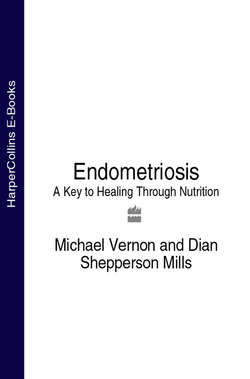Читать книгу Endometriosis: A Key to Healing Through Nutrition - Michael Vernon - Страница 7
Foreword
ОглавлениеWomen with endometriosis commonly complain that doctors do not take their symptoms seriously. There is a feeling that if doctors did listen and if only doctors knew more about endometriosis, women would not have to suffer years of pain without a definitive diagnosis. The frustration is justified as recent research has shown that it usually takes about ten years from the onset of symptoms for the diagnosis to be made.
I think that this apparent indifference to symptoms, such as painful periods and painful sex, merely reflects the lack of interest shown by society in general to health problems that are specific to women. I also think that sufferers themselves should be trying to raise awareness about endometriosis among both the medical profession and the general public. Endometriosis should be as well known as asthma or diabetes given how many women it affects and how much misery it creates.
The principal problem, however, is that not enough is known about the condition. Despite over 20 years of intensive research, we still do not understand what causes endometriosis; why there is such discrepancy between the intensity of symptoms and the severity of disease, or how best to treat patients. When doctors struggle in the dark because they do not comprehend a condition, it is inevitable that patients will receive care that they perceive to be unsatisfactory.
The other common complaint I hear is that sufferers feel restricted by the inability of many doctors to explain, using language that can be understood, the nature of the disease and the treatment options available. It is clear from recent research in Oxford that the failure to meet the information needs of sufferers leads to disillusion and a sense of disempowerment.
I believe that it is vital to provide women with high quality information, especially about treatment, to enable them to make the kind of important decisions that may potentially have a profound effect upon their lives. The reality, however, is that the treatment options are limited and the medications currently available rarely provide a cure. Therefore it is understandable that sufferers should seek complementary therapies that allow them to take control over their own bodies.
This book is unique because, for the first time, a highly respected scientist has teamed up with a nutritionist who uses complementary medicine, to give women a better understanding of the scientific basis for the use of nutritional therapies that many women around the world have found helpful. It should give encouragement to those in despair because conventional treatments have failed or produced unacceptable side effects. Eating healthily produces only good side effects.
The authors provide considerable evidence illustrating the role of basic nutrients in metabolic pathways involved in the normal menstrual cycle and pain-associated inflammation. Generally speaking, the medical profession has been slow to appreciate the importance of nutrients in the prevention and treatment of disease. For example, it has only recently been accepted that folic acid should be given to all women planning to conceive, so as to prevent neural tube defects. Much of what is said in this book, however, is common sense: eat well and your body will benefit. What is new is that Dian Mills and Michael Vernon provide the rationale for doing so in a condition that traditionally has been treated only with hormonal drugs and surgery. A holistic approach to endometriosis is vitally important because of the limitations of conventional medicine, and the authors are to be congratulated for providing the reader with a number of novel strategies for coping with this debilitating condition.
Stephen Kennedy
SENIOR FELLOW IN REPRODUCTIVE MEDICINE
UNIVERSITY OF OXFORD
